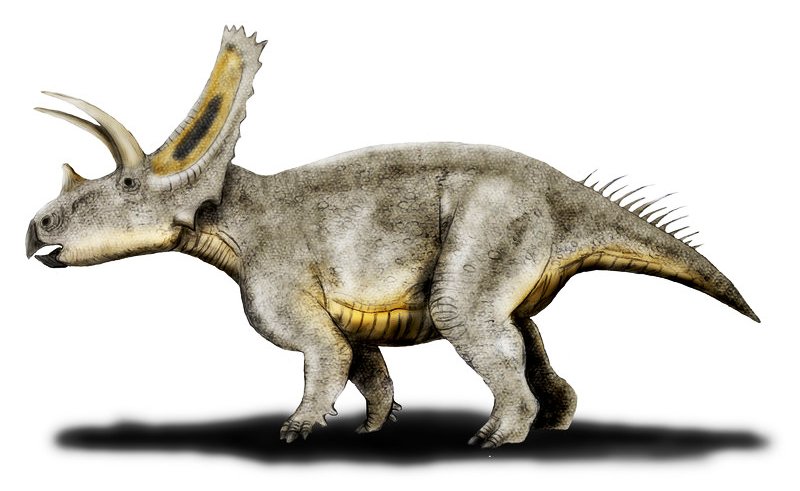Post by dinosauria101 on Jul 11, 2019 16:40:23 GMT 5
Therizinosaurus cheloniformis
Therizinosaurus is a genus of very large theropod dinosaurs. Therizinosaurus comprises the single species T. cheloniformis, which lived in the late Cretaceous Period (early Maastrichtian stage, around 70 million years ago), and was one of the last and largest representatives of its unique group, the Therizinosauria. Fossils of this species were first discovered in Mongolia and were originally thought to belong to a turtle-like reptile (hence the species name, T. cheloniformis – "turtle-formed"). It is known only from a few bones, including gigantic hand claws, from which it gets its name. Though the fossil remains of Therizinosaurus are incomplete, inferences can be made about their physical characteristics based on related therizinosaurids. Like other members of their family, Therizinosaurusprobably had small skulls atop long necks, with bipedal gaits and heavy, deep, broad bodies (as evidenced by the wide pelvis of other therizinosaurids). Their forelimbs may have reached lengths of up to 2.5 metres (8.2 feet) or even 3.5 metres (11.5 feet) in the largest known specimen. Their hindlimbs ended in four weight-bearing toes, unlike other theropod groups, in which the first toe was reduced to a dewclaw. In 2010 Gregory S. Paul estimated the maximum size of Therizinosaurus at 10 metres (33 ft) in length and five tonnes in weight. They are the largest therizinosaurs known, and the largest known maniraptorans. The most distinctive feature of Therizinosaurus was the presence of gigantic claws on each of the three digits of their front limbs. These were common among therizinosaurs but especially large in Therizinosaurus, and while the largest claw specimens are incomplete, they probably reached 0.7–1 metres (2.3–3.3 ft) in length. The claws are the longest known from any animal. The claws were relatively straight, only gradually tapering into a point, as well as extremely narrow and transversely flattened.

Titanoceratops ouranos
Titanoceratops (meaning "titanic horn face") is a genus of herbivorous ceratopsian dinosaur. It was a giant chasmosaurine ceratopsian which lived during the Late Cretaceous period (late Campanian, 74.5–73.7 Ma) in what is now New Mexico, and the earliest known triceratopsin. It is known solely from the holotype OMNH 10165, a partial skeleton including partial skull and jaws. The holotype is thought to come from the upper Fruitland Formation or the lower Kirtland Formation based on field notes and the lithology of the matrix surrounding the fossils, but unfortunately the precise location of the quarry is no longer known. The species was formally named by Nicholas R. Longrich in 2011 and the type species is Titanoceratops ouranos. Previously, its fossils were assigned to Pentaceratops. The skull is estimated to be 2.65 m (8.7 ft) long when complete, making it a candidate for the longest skull of any terrestrial vertebrate. It would have been at least 6.8 meters long (22.3 ft) and at least 6.5 tons in weight. Tom Holtz (2010) noted that it is extremely similar to its closely related contemporaries Eotriceratops and Ojoceratops,

Credit to Wikipedia
Therizinosaurus is a genus of very large theropod dinosaurs. Therizinosaurus comprises the single species T. cheloniformis, which lived in the late Cretaceous Period (early Maastrichtian stage, around 70 million years ago), and was one of the last and largest representatives of its unique group, the Therizinosauria. Fossils of this species were first discovered in Mongolia and were originally thought to belong to a turtle-like reptile (hence the species name, T. cheloniformis – "turtle-formed"). It is known only from a few bones, including gigantic hand claws, from which it gets its name. Though the fossil remains of Therizinosaurus are incomplete, inferences can be made about their physical characteristics based on related therizinosaurids. Like other members of their family, Therizinosaurusprobably had small skulls atop long necks, with bipedal gaits and heavy, deep, broad bodies (as evidenced by the wide pelvis of other therizinosaurids). Their forelimbs may have reached lengths of up to 2.5 metres (8.2 feet) or even 3.5 metres (11.5 feet) in the largest known specimen. Their hindlimbs ended in four weight-bearing toes, unlike other theropod groups, in which the first toe was reduced to a dewclaw. In 2010 Gregory S. Paul estimated the maximum size of Therizinosaurus at 10 metres (33 ft) in length and five tonnes in weight. They are the largest therizinosaurs known, and the largest known maniraptorans. The most distinctive feature of Therizinosaurus was the presence of gigantic claws on each of the three digits of their front limbs. These were common among therizinosaurs but especially large in Therizinosaurus, and while the largest claw specimens are incomplete, they probably reached 0.7–1 metres (2.3–3.3 ft) in length. The claws are the longest known from any animal. The claws were relatively straight, only gradually tapering into a point, as well as extremely narrow and transversely flattened.

Titanoceratops ouranos
Titanoceratops (meaning "titanic horn face") is a genus of herbivorous ceratopsian dinosaur. It was a giant chasmosaurine ceratopsian which lived during the Late Cretaceous period (late Campanian, 74.5–73.7 Ma) in what is now New Mexico, and the earliest known triceratopsin. It is known solely from the holotype OMNH 10165, a partial skeleton including partial skull and jaws. The holotype is thought to come from the upper Fruitland Formation or the lower Kirtland Formation based on field notes and the lithology of the matrix surrounding the fossils, but unfortunately the precise location of the quarry is no longer known. The species was formally named by Nicholas R. Longrich in 2011 and the type species is Titanoceratops ouranos. Previously, its fossils were assigned to Pentaceratops. The skull is estimated to be 2.65 m (8.7 ft) long when complete, making it a candidate for the longest skull of any terrestrial vertebrate. It would have been at least 6.8 meters long (22.3 ft) and at least 6.5 tons in weight. Tom Holtz (2010) noted that it is extremely similar to its closely related contemporaries Eotriceratops and Ojoceratops,

Credit to Wikipedia


